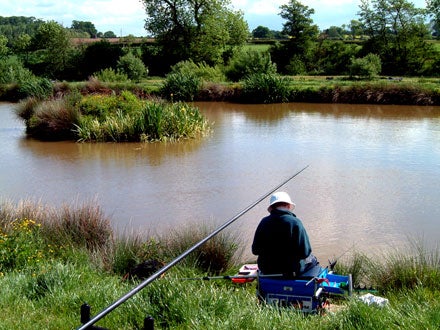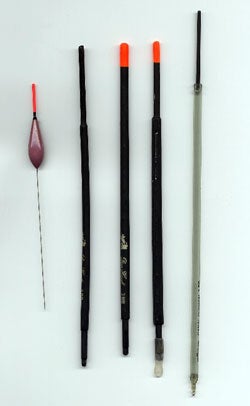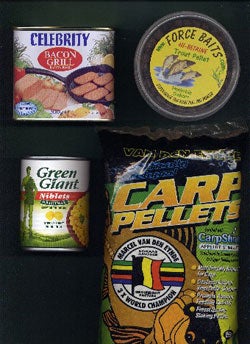| MARK WINTLE |
| Mark Wintle, an angler for over thirty-five years, is on a quest to discover and bring to you the magic of fishing. Previously heavily involved with match fishing he now fishes for the sheer fun of it. With an open and enquiring mind, each week Mark will bring to you articles on fishing different rivers, different methods and what makes rivers, and occasionally stillwaters, tick. Add to this a mixed bag of articles on catching big fish, tackle design, angling politics and a few surprises. Are you stuck in a rut fishing the same swim every week? Do you dare to try something different and see a whole new world of angling open up? Yes? Then read Mark Wintle’s regular weekly column. |
PLEASURE FISHING COMMERCIALS First, find your fish. Get ’em feeding, and then catch ’em. But how do you know when you’ve got a bite? And is the method that you favour always the best one? Though I must wait for the ‘proper’ season to begin to do the fishing I like best, river fishing, along with many others I find it’s good to get out on a fine spring day and catch a few fish (beats mowing the lawn). With the rivers shut, and most club stillwaters also closed, the best bet is one of the many commercial day ticket venues that have sprung up over the last twenty years. So, this article is very much aimed at the pleasure angler who’s happy to catch a few small carp, tench, roach or bream (always a chance of crucians, perch and orfe). Although these might not be everyone’s cup of tea, you can’t fault the convenience. Good car parking, short walks, plenty of fish to catch and easy fishing make this type of venue a good choice for the busy angler wanting to fit in a few hours fishing in a weekend. With a bit of careful planning, it’s possible to catch plenty of fish from these venues with a minimum of bait and simple tackle. During early April, I got out on three of these waters and it quickly became apparent that the average pleasure angler needs help in catching fish, even on waters as well stocked as these. Those anglers used to regular match fishing have few difficulties. Their pole and feeding expertise soon have the fish lining up. This is the point that the average pleasure angler finds hard to understand. It’s no good reading how Bob Nudd or Alan Scotthorne heaves out 200lb of fish when you’re fishing with a £ 40 match rod and cheap fixed spool reel. These guys won the world championships time after time because they were the best in the world at their type of fishing, and as far as gear is concerned, money is no object. Add brilliant technique, and it’s hardly surprising that they regularly try to empty the lake. But with simple tackle and technique, and straight-forward bait requirements there is no reason why an average angler shouldn’t land a few rod-benders. I’m therefore going to look at some of the simple errors that the average pleasure angler makes and how these can easily be put right. Do that and hopefully your catches will improve. Find the fish
Different types of fish inhabit different types of swim; carp are often amongst island reed beds, roach in open water, and crucians and big perch right under your feet! It is hardly surprising that pole tactics that enable the angler to precisely position his bait against a reed bed can be very successful. But before you select your swim, take the time to ask the fishery manager where good swims are, and how best to tackle them. Half an hour gleaning information is better than wasting five hours catching nothing. So, make a promise to yourself that fishing a spot because it looks comfortable is going to change to fishing a spot because it holds plenty of fish, and what’s more, you know something about how best to tackle that swim. Keep the tackle simple With two spools loaded within an eighth of an inch of the lip, with say 21/2 lb on one spool and 5lb on the other, you’ve got a good basis to catch some fish. Add a selection of light wagglers taking from 3BB to 3AAA, split-shot; AAA, BB, 1, 4, 8, a catapult and some barbless hooks, and you are nearly there. In shallow water, there is a good case for keeping the shotting pattern very simple. Put almost all of the bulk shot around the base of the float with just a number 8 every eighteen inches down the line. Many pleasure anglers shot these floats with a string of no. 1 shot like a pearl necklace. The light shotting I advocate lets the bait fall slowly to the bottom like your feed, helping to fool the fish. I often stick with this in much deeper water, for it’s easy to cast. Plumb the depth quietly by using a swan-shot pinched on the hook. A good starting point is to have the float set slightly over depth. You may find that as your session progresses that the fish start to swirl on the top, and it may pay to set the float shallower. A good tip for casting wagglers is to try to allow the waggler to be at least four or five feet below the rod tip when you cast. This makes the rod wind-up the power better and casting becomes effortless. Practice your casting. If you miscast, reel in and cast again, and be determined to get your float in the right spot. Bait and feeding
As I mentioned earlier regarding finding good swims, it is worth talking to the fishery manager and other anglers about the best baits. I find that more and more when fishing these commercial fisheries that feeding a few pellets every cast, and fishing either a hookable pellet, or corn or meat, provides plenty of sport. For roach, a pint of casters still takes some beating. Big roach on these fisheries can be crafty though. It may pay to fish a tiny pole float set very shallow to catch them. Constant drip feeding of half a dozen casters can get them fighting over the casters in time, and then they become catchable. One of the craftiest ways to lure a big perch (if you know they’re present in the lake) is to fish single maggot on a twenty close in, regularly loose feeding a dozen maggots. What attracts the perch is constantly releasing small roach under your feet. It pays to sit back a few feet. After a couple of hours, lip hook a small roach on a size 8 with 5lb line and drop it in by your feet. The perch will ambush it. Regular feeding is essential The most basic error that the average pleasure angler makes is failing to feed often enough, especially in the warmer months. It happens something like this. The average angler starts well enough, feeding every cast, and after a short while, maybe twenty minutes starts to get a fish or two. After each fish he feeds again, but after three or four fish, the fish shy away and all goes quiet. This is the point where it all goes wrong. Those fish will return but it might be a good hour before they come back. If you can keep that feed going in regularly throughout your session there will be some feed to hold them when they return. But allow that feeding to stop and the fish will seek better-fed swims elsewhere. The large shoals of carp that move around these fisheries are looking for bait dropping through the water. If you can keep a steady trickle of pellets dropping through your swim then you must have a chance of attracting them. I have taught many novice anglers, and sometimes you almost need a metronome to train people to feed regularly. This is only a taster on helping you to catch more fish from what are comparatively easy venues. There is much more information on this site, especially in the Technique section under First Class Fishing. Next week: ‘Over-fishing’ |
















